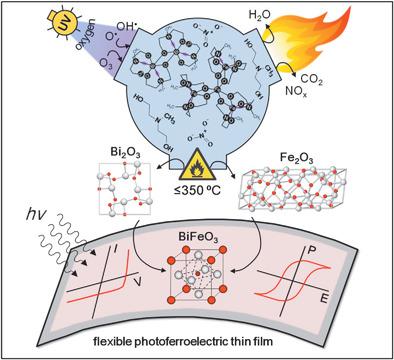当前位置:
X-MOL 学术
›
Adv. Funct. Mater.
›
论文详情
Our official English website, www.x-mol.net, welcomes your feedback! (Note: you will need to create a separate account there.)
Photoferroelectric Thin Films for Flexible Systems by a Three‐in‐One Solution‐Based Approach
Advanced Functional Materials ( IF 19.0 ) Pub Date : 2020-06-25 , DOI: 10.1002/adfm.202001897 Iñigo Bretos 1 , Ricardo Jiménez 1 , Jesús Ricote 1 , Rafael Sirera 2 , M. Lourdes Calzada 1
Advanced Functional Materials ( IF 19.0 ) Pub Date : 2020-06-25 , DOI: 10.1002/adfm.202001897 Iñigo Bretos 1 , Ricardo Jiménez 1 , Jesús Ricote 1 , Rafael Sirera 2 , M. Lourdes Calzada 1
Affiliation

|
The effective incorporation of (multi)functional oxides into next‐generation flexible electronics systems requires novel fabrication technologies that enable the direct integration of crystalline oxide layers in them. Unfortunately, this is considerably challenging due to the thermal incompatibility between the crystallization temperatures of metal oxides (>600 °C) and the thermal stability of the flexible polymer substrates conventionally used (<400 °C). Here, it is shown that BiFeO3 thin films can be grown on flexible plastic by solution processing involving three different but complementary strategies to induce the crystallization of the perovskite phase at a lower temperature limit of 325 °C. This “three‐in‐one” approach is based on the synthesis of tailored metal precursors i) with a molecular structure resembling the crystalline structure of the oxide phase, which additionally allows both ii) photochemical and iii) internal combustion reactions taking place in the thin films. The flexible BiFeO3 thin films obtained from a specifically designed molecular complex with N‐methyldiethanolamine yield a large remnant polarization of 17.5 µC cm−2, also showing photovoltaic and photocatalytic effects. This result paves the way for the direct integration of an interesting class of oxides with photoferroelectric properties in flexible devices with multiple applications in information and communication technology, and energy.
中文翻译:

基于三合一解决方案的方法用于柔性系统的光电铁薄膜
将(多功能)氧化物有效地结合到下一代柔性电子系统中需要新颖的制造技术,这些技术能够使其中的晶体氧化物层直接集成在一起。不幸的是,由于金属氧化物的结晶温度(> 600°C)与常规使用的柔性聚合物基材的热稳定性(<400°C)之间的热不相容性,这是非常具有挑战性的。此处显示BiFeO 3薄膜可以通过涉及三种不同但互补的策略的固溶处理在柔性塑料上生长,以在325°C的较低温度极限下诱导钙钛矿相的结晶。这种“三合一”方法是基于合成的金属前体i),其分子结构类似于氧化物相的晶体结构,另外还允许ii)光化学和iii)在反应中发生内燃反应。薄膜。由专门设计的分子与N-甲基二乙醇胺形成的分子络合物获得的柔性BiFeO 3薄膜产生了17.5 µC cm -2的大残留极化,也显示出光伏和光催化作用。这一结果为在具有信息和通信技术以及能源的多种应用的柔性设备中将具有光铁电性质的一类有趣的氧化物直接集成铺平了道路。
更新日期:2020-08-08
中文翻译:

基于三合一解决方案的方法用于柔性系统的光电铁薄膜
将(多功能)氧化物有效地结合到下一代柔性电子系统中需要新颖的制造技术,这些技术能够使其中的晶体氧化物层直接集成在一起。不幸的是,由于金属氧化物的结晶温度(> 600°C)与常规使用的柔性聚合物基材的热稳定性(<400°C)之间的热不相容性,这是非常具有挑战性的。此处显示BiFeO 3薄膜可以通过涉及三种不同但互补的策略的固溶处理在柔性塑料上生长,以在325°C的较低温度极限下诱导钙钛矿相的结晶。这种“三合一”方法是基于合成的金属前体i),其分子结构类似于氧化物相的晶体结构,另外还允许ii)光化学和iii)在反应中发生内燃反应。薄膜。由专门设计的分子与N-甲基二乙醇胺形成的分子络合物获得的柔性BiFeO 3薄膜产生了17.5 µC cm -2的大残留极化,也显示出光伏和光催化作用。这一结果为在具有信息和通信技术以及能源的多种应用的柔性设备中将具有光铁电性质的一类有趣的氧化物直接集成铺平了道路。



























 京公网安备 11010802027423号
京公网安备 11010802027423号